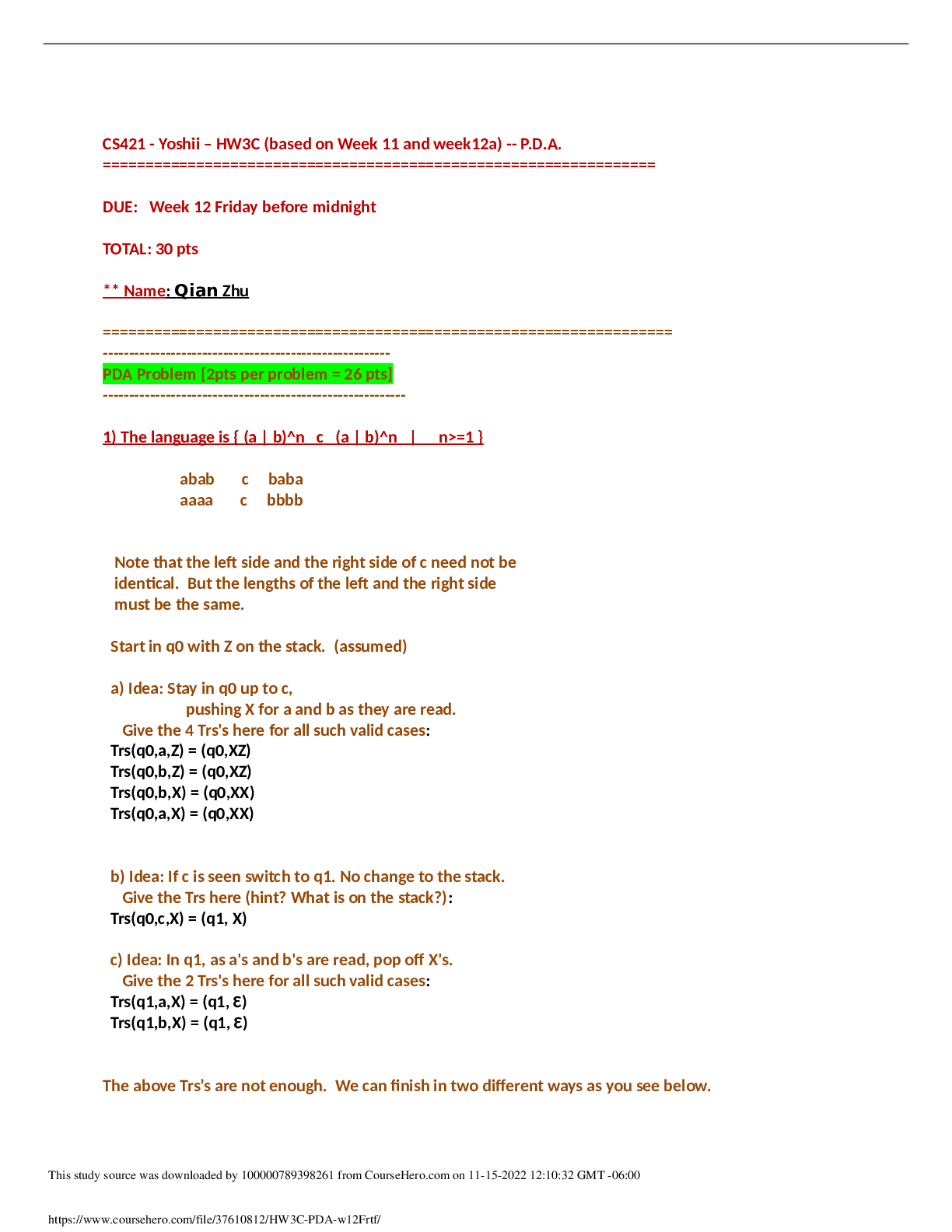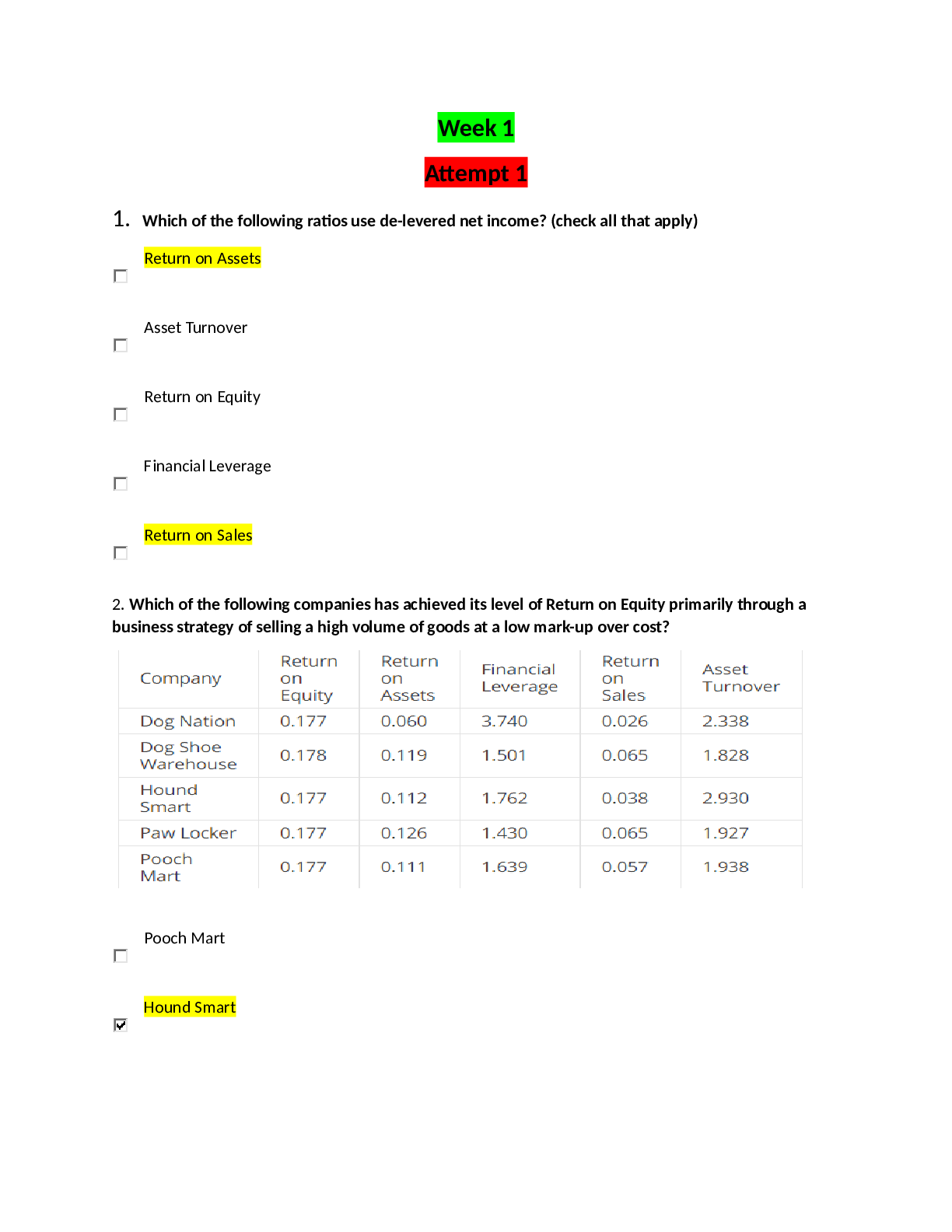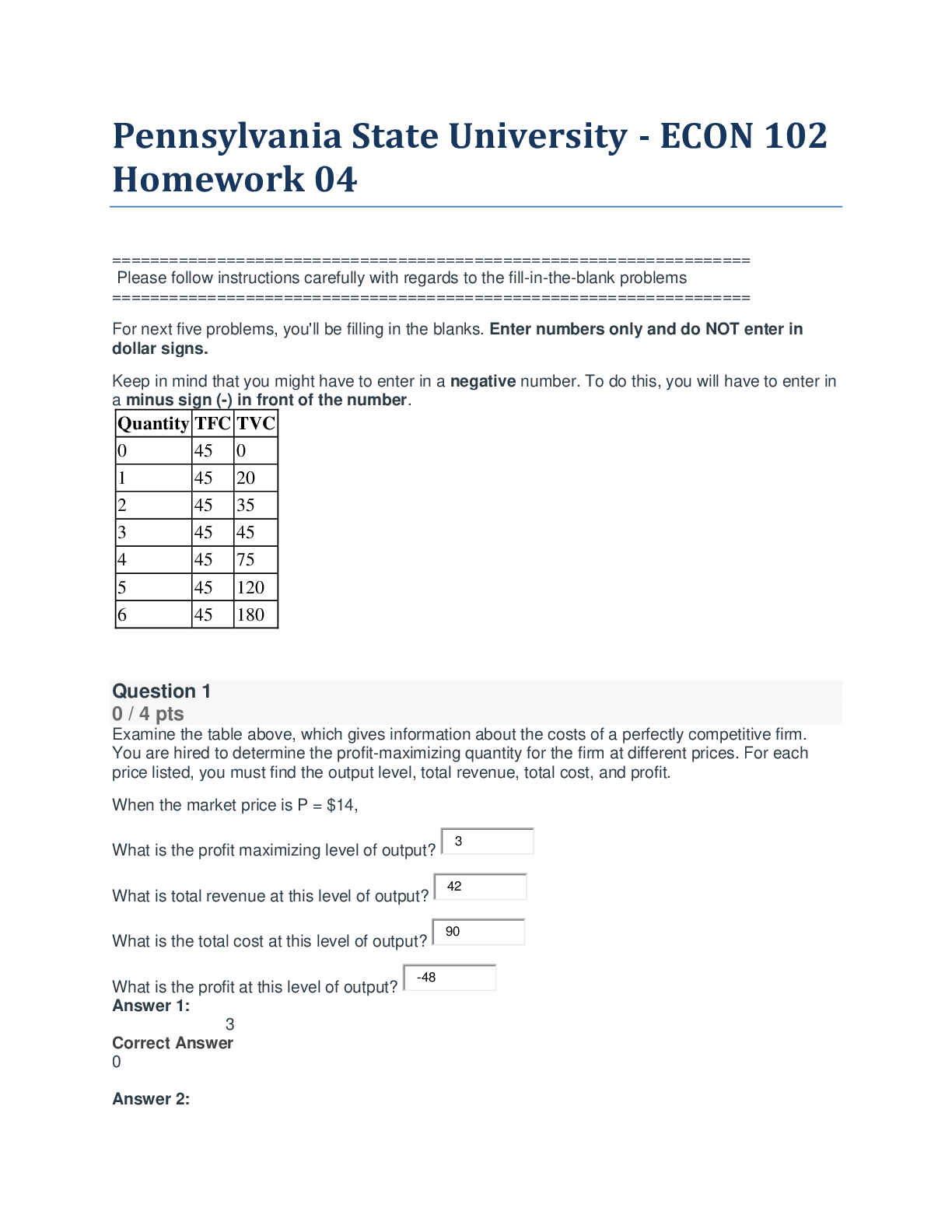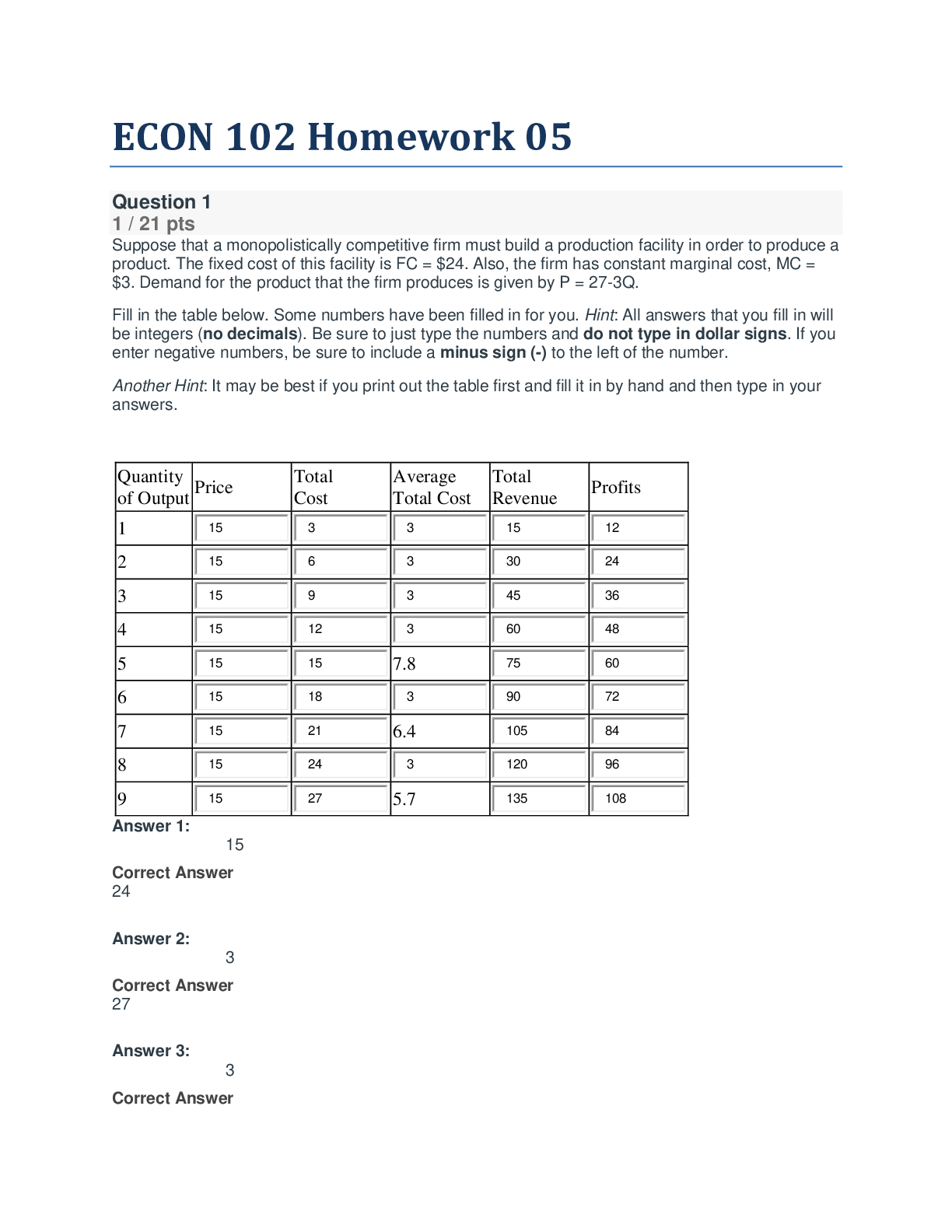Economics > QUESTIONS & ANSWERS > Eastern Michigan University - ECON 202ECON 202 Exam 2 Fall Semester. 85% Pass Rate (All)
Eastern Michigan University - ECON 202ECON 202 Exam 2 Fall Semester. 85% Pass Rate
Document Content and Description Below
ECON 202ECON 202 Exam 2 Fall Semester Question 1 1.25 out of 1.25 points Refer to the above table. What does the marginal product equal when the quantity of labor goes from 2 to 3? ... Selected Answer: 17 Question 3 0 out of 1.25 points Refer to the above table. When the quantity of labor equals 4, what does the average product equal? Selected Answer: 72 Question 4 1.25 out of 1.25 points Suppose that at the current level of output, price = $10, MC = $14, AVC = $7, and ATC = $9. Which of the following is true? Selected Answer: The firm should decrease output. Question 5 0 out of 1.25 points A firm has the following production relationship between labor and output, for a fixed capital stock. According to the above table, what is the marginal product of the 5th unit of labor? Selected Answer: 5.2 Question 6 1.25 out of 1.25 points The short run is Selected Answer: the period of time in which the firm cannot change its use of at least one input. Question 7 1.25 out of 1.25 points Refer to the above table. When output rises from 2 units to 3 units, marginal costs are Selected Answer: $10. Question 8 1.25 out of 1.25 points When a firm is earning zero economic profits, Selected Answer: P = ATC. Question 9 1.25 out of 1.25 points A production function is a(n) Selected Answer: technological relationship. Question 10 1.25 out of 1.25 points The planning horizon is the Selected Answer: long run. Question 11 1.25 out of 1.25 points Which is always true at a firm's profit-maximizing rate of production? Selected Answer: Marginal Revenue = Marginal Cost Question 12 1.25 out of 1.25 points The firm's short-run costs contain Selected Answer: both variable and fixed costs. Question 13 1.25 out of 1.25 points A decrease in the long-run average costs resulting from increasing output is referred to as Selected Answer: economies of scale. Question 14 1.25 out of 1.25 points Refer to the above table. The table represents information on the costs for Ajax Corporation. Ajax operates in a perfectly competitive market and the price of the product is $9. What does profit equal when quantity equals 4? Selected Answer: $6 Question 15 1.25 out of 1.25 points In the long run, a firm can change Selected Answer: all inputs. Question 16 0 out of 1.25 points The focus of firm decisions in the short run is primarily on Selected Answer: plant size. Question 17 1.25 out of 1.25 points Minimum efficient scale Selected Answer: is the lowest rate of output per unit of time at which long-run average costs reach a minimum for a particular firm. Question 18 1.25 out of 1.25 points Refer to the above figure. Diseconomies of scale exist Selected Answer: after output Q5. Question 19 0 out of 1.25 points In the above figure, when price is below E, this firm should Selected Answer: attempt to lower ATC and to raise AVC. Question 20 1.25 out of 1.25 points Suppose a perfectly competitive asparagus farm can produce six containers of asparagus at an output at which marginal cost equals marginal revenue. The price per container of asparagus is $100 and the average total cost is $75. What is the profit or loss that this asparagus farm is earning? Selected Answer: $150.00 Question 21 0 out of 1.25 points Accounting profits at a firm's break-even point are Selected Answer: zero. Question 22 1.25 out of 1.25 points In the model of perfect competition, the market demand curve is found by Selected Answer: horizontally summing the demand curves of individual consumers. Question 23 1.25 out of 1.25 points When the average physical product is falling, Selected Answer: average variable costs are rising. Question 24 1.25 out of 1.25 points The total cost of the firm Selected Answer: includes implicit and explicit costs. Question 25 1.25 out of 1.25 points In the above figure, the long-run cost curve between points E and F illustrates Selected Answer: diseconomies of scale. Question 26 1.25 out of 1.25 points Any activity that results in the conversion of resources into products that can be used in consumption is Selected Answer: production. Question 27 1.25 out of 1.25 points Which of the following is correct? Selected Answer: TC = TFC + TVC Question 28 1.25 out of 1.25 points Which of the following statements about a firm's short-run variable costs is correct? Selected Answer: They typically include the cost of workers' wages. Question 29 1.25 out of 1.25 points The short-run supply curve of a perfect competitor is Selected Answer: its marginal cost curve equal to or above the minimum point on its average variable cost curve. Question 30 1.25 out of 1.25 points Total fixed cost is Selected Answer: the cost that does not change as output changes. Question 31 1.25 out of 1.25 points The observation that beyond some point, successive increases in a variable factor of production added to a fixed factor of production lead to smaller and smaller increases in output is Selected Answer: the law of diminishing marginal product. Question 32 0 out of 1.25 points In the above figure, point B is called Selected Answer: the point of diminishing marginal product. Question 33 1.25 out of 1.25 points Which of the following physical relationships might generate economies of scale? Selected Answer: Proportionally larger pipes can transport more than a proportional increase in oil. Question 34 1.25 out of 1.25 points The law of diminishing marginal product shows the relationship Selected Answer: between inputs and outputs for a firm in the short run. Question 35 1.25 out of 1.25 points The typical cost curves are U-shaped due to the Selected Answer: law of diminishing marginal product. Question 36 1.25 out of 1.25 points If a perfect competitor faces P = ATC in the long run, the firm will Selected Answer: remain in the industry. Question 37 1.25 out of 1.25 points Refer to the above figure. Profits for this firm are positive Selected Answer: for points between B and C. Question 38 0 out of 1.25 points Malfeasance at Enron, a Houston-based energy firm, led to overstatement of revenues by almost $92 billion. As Enron closed its operations, U.S. energy prices remained stable. This may have been evidence that Selected Answer: there was lack of any competition, so Enron was the winner. Question 39 0 out of 1.25 points Economic efficiency means Selected Answer: that all firms within a single competitive industry are producing at the same level of output. Question 40 0 out of 1.25 points In the above figure, the long-run cost curve between points C and D illustrates Selected Answer: diseconomies of scale. Question 41 1.25 out of 1.25 points If four laborers were hired and we discovered that we could produce 88 units of production, what is the average physical product of labor? Selected Answer: 22 Question 42 1.25 out of 1.25 points Average variable costs equal Selected Answer: total variable costs divided by output. Question 43 1.25 out of 1.25 points The shutdown rule for a firm in a perfectly competitive industry is that the firm should cease production if Selected Answer: P < AVC. Question 44 1.25 out of 1.25 points If the long-run supply curve is horizontal, we know that this is Selected Answer: a constant-cost industry. Question 45 1.25 out of 1.25 points Production Selected Answer: is a process by which resources are transferred into goods and services. Question 46 1.25 out of 1.25 points In the above table, the average physical product of the 3rd worker is Selected Answer: 4. Question 47 0 out of 1.25 points With a given plant size, an increase in output will NOT result in an increase in Selected Answer: total cost. Question 48 0 out of 1.25 points Suppose a perfectly competitive firm faces the following cost and revenue conditions: ATC = $25.50; AVC = $20.50; MC = $25.50; MR = $28.50. The firm should Selected Answer: continue to produce its current output. Question 49 1.25 out of 1.25 points Refer to the above table. What are total variable costs at an output of 2 units? Selected Answer: $50 Question 50 0 out of 1.25 points Which of the following statement is correct? Selected Answer: When Marginal Product is greater than Average Physical Product, Average Physical Product is equal to Total Product. [Show More]
Last updated: 2 years ago
Preview 1 out of 12 pages

Buy this document to get the full access instantly
Instant Download Access after purchase
Buy NowInstant download
We Accept:

Reviews( 0 )
$12.00
Can't find what you want? Try our AI powered Search
Document information
Connected school, study & course
About the document
Uploaded On
Jan 28, 2021
Number of pages
12
Written in
Additional information
This document has been written for:
Uploaded
Jan 28, 2021
Downloads
0
Views
67






.png)
.png)
.png)
.png)
.png)
.png)
.png)













